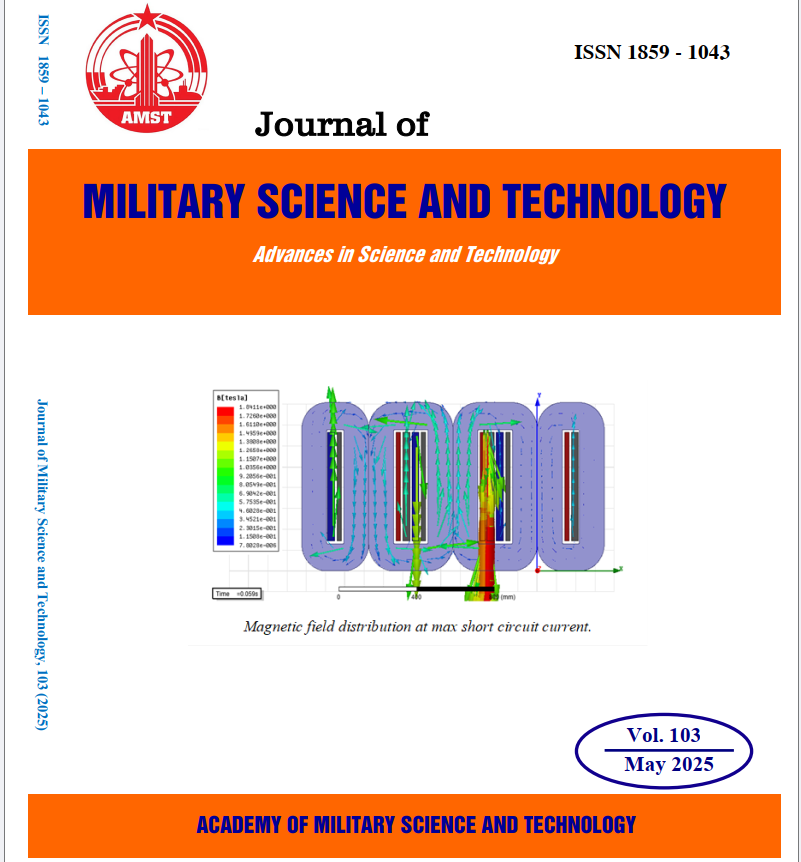Synthesis and thermal characterization of γ-Glycidoxypropyltrimethoxysilane modified phenol-formaldehyde resin
371 viewsDOI:
https://doi.org/10.54939/1859-1043.j.mst.103.2025.47-54Keywords:
Phenol-formaldehyde (PF)resin; KH-560; Thermal characterization; DSC; TGA.Abstract
This study investigates the synthesis of γ-Glycidoxypropyltrimethoxysilane (KH-560) modified phenol-formaldehyde (PF) resin and its thermal properties. The modification aimed to improve the thermal stability of the PF resin by forming covalent linkages through KH-560. The successful incorporation of KH-560 into the PF resin was confirmed by Fourier Transform Infrared Spectroscopy (FTIR) and proton Nuclear Magnetic Resonance (¹H NMR) analyses. Thermal characterization using Differential Scanning Calorimetry (DSC) revealed that the KH-560 modification led to an increase in the curing temperature and a enhanced exothermic curing reaction compared to the unmodified resin. Thermogravimetric Analysis (TGA) demonstrated an improvement in the thermal stability of the modified PF resin, with higher decomposition temperatures and slower decomposition rates compared to the unmodified resin. These findings confirm that KH-560 is an effective modifier for enhancing the thermal properties of PF resin.
References
[1]. A. Gardziella, L. A. Pilato and A. Knop. "Phenolic resins: Chemistry, applications, standardization, safety and ecology". Springer, (2000). DOI: https://doi.org/10.1007/978-3-662-04101-7
[2]. C. E. Carraher Jr. "Introduction to polymer chemistry". CRC press, (2017). DOI: https://doi.org/10.1201/9781315369488
[3]. J. Xu, N. Brodu, M. Mignot, B. Youssef and B. Taouk. "Synthesis and characterization of phenolic resins based on pyrolysis bio-oil separated by fractional condensation and water extraction". Biomass and Bioenergy, 159, 106393, (2022). DOI: https://doi.org/10.1016/j.biombioe.2022.106393
[4]. M. Patel, M. Yadav and M. Raj. "Development in the modification of phenolic resin by renewable resources:(A-Review)". Oriental Journal of Chemistry, 39, (2023). DOI: https://doi.org/10.13005/ojc/390407
[5]. Y. Zhang, Y. Liu, D. Jiang, M. Shalash, S. M. El-Bahy, Z. Wu, J. Ren, Z. Guo and Z. M. El-Bahy, "A comprehensive review on modified phenolic resin composites for enhanced performance across various applications". Polymer Composites. 10.1002/pc.29537, (2025). DOI: https://doi.org/10.1002/pc.29537
[6]. Q. Wei and W.-H. Wang. "Properties of phenol formaldehyde resin modified with silane coupling agent (KH550)". International Journal of Adhesion and Adhesives, 84, 166-172, (2018). DOI: https://doi.org/10.1016/j.ijadhadh.2018.03.006
[7]. X. Wang, Q. Xu, Q. Zheng, Y. Shao and J. Shen. "Reviews of fiber-reinforced phenolic resin-based thermal protection materials for aircraft". Energies, 18, 819, (2025). DOI: https://doi.org/10.3390/en18040819
[8]. P. Zhang, S. Wang, X. Zhang and X. Jing. "The effect of free dihydroxydiphenylmethanes on the thermal stability of novolac resin". Polymer Degradation and Stability, 168, 108946, (2019). DOI: https://doi.org/10.1016/j.polymdegradstab.2019.108946
[9]. H. H. Wu and P. P. Chu. "Degradation kinetics of functionalized novolac resins". Polymer Degradation and Stability, 95, 1849-1855, (2010). DOI: https://doi.org/10.1016/j.polymdegradstab.2010.04.024
[10]. Z. Zhang, W. Sun, W. Huang, Y. Zhu, J. Li, C. Liang and S. Gao, "Interfacial and mechanical properties of silane coupling agent interface-modified basalt fiber reinforced thermoplastic polypropylene resin composites". Polymer Composites, 46(7): 6582-6593, (2025). DOI: https://doi.org/10.1002/pc.29379
[11]. J. Gu, Q. Zhang, J. Dang, J. Zhang and S. Chen. "Preparation and mechanical properties researches of silane coupling reagent modified β-silicon carbide filled epoxy composites". Polymer Bulletin, 62, 689-697, (2009). DOI: https://doi.org/10.1007/s00289-009-0045-z
[12]. F. Billes and I. Mohammed‐Ziegler. "Vibrational spectroscopy of phenols and phenolic polymers. Theory, experiment, and applications". Applied Spectroscopy Reviews, 42, 369-441, (2007). DOI: https://doi.org/10.1080/00102200701421748
[13]. Y. Yu, X. Qiu, C. Li, D. Bao and J. Chang. "Performance and characterization of phenol-formaldehyde resin with crude bio-oil by model compound method". PLOS ONE, 18, e0271478, (2023). DOI: https://doi.org/10.1371/journal.pone.0271478
[14]. Z. Ge, H. Ren, S. Fu and S. Chen. "Synergistic effects of zwitterionic segments and a silane coupling agent on zwitterionic shape memory polyurethanes". RSC Advances, 7, 42320-42328, (2017). DOI: https://doi.org/10.1039/C7RA06759C







